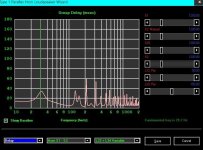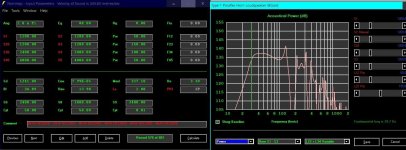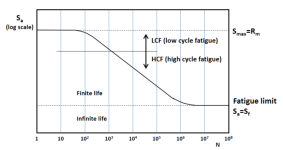The lower you go and the more air (Xmax) is going to get displaced the larger the BR can be. It also depends on the driver T/S-parameters, it's just that most 18" are designed with practical size restraints in mind. And at a certain point T/S-parameters became such that a open baffle or infinite baffle makes more sense.
Ic, so connecting the dots there is no such a thing as one solution fits all, current production PA sub drivers are designed for practical enclosure sizes , some better suit BR , FLH , TH ,BP ,TL etc etc.
And some speaker cabinet brands ask a driver manufacturer house to roll out some OEM driver specific to a box they design with unique TS parameters ,such was the case of the EAW bertha if I am not mistaken.
At the time there was not strong enough drivers made for public consumption so one was asked to be made for this particular cab.
Today I think you can replicate the bertha and stick the DS series from BC or some 18sound and they will bang away and not explode.
A FLH can be quite large if it was calculated for sub duty, but it is one design that can take a the modest power and Xmax rated drivers of that era.
Today with the kW rated driver and Xmax ratings 16+ other types of enclosures can be much smaller than a FLH and crank out the same SPL.
The FLH is the cabinet type that when you cluster it the Fb goes lower?
What puzzles me is why the BR is king regarding models that are in current production , is it because lower cost of manufacturing?
But I think that pack size is one major factor on size of the cabinet ,one is the pickup standard pack size and the other is the 18 wheelers sizes for big systems like touring acts.
Then we move to the exotics 400+lbs multi driver monsters that are to be installed not moved or moved by crane and or forklift , DSL Jericho comes to mind.
BL is the motor force , and you need strong motor for TH cabinets , but where is the cone strength parameter if there is any?
I have read over here they you need strong cone drivers for high compression TH cabinets >3
But cone strength is not a oficial TS parameter is it ?
As looks like by trial and error people find drivers that can survive a high compression enclosure and others that they advice not to use as they will have their cones shredded to pieces if you dare to use one in a HCR cabinet.
A high BL driver do not guarantee a strong cone right ?
And some speaker cabinet brands ask a driver manufacturer house to roll out some OEM driver specific to a box they design with unique TS parameters ,such was the case of the EAW bertha if I am not mistaken.
At the time there was not strong enough drivers made for public consumption so one was asked to be made for this particular cab.
Today I think you can replicate the bertha and stick the DS series from BC or some 18sound and they will bang away and not explode.
A FLH can be quite large if it was calculated for sub duty, but it is one design that can take a the modest power and Xmax rated drivers of that era.
Today with the kW rated driver and Xmax ratings 16+ other types of enclosures can be much smaller than a FLH and crank out the same SPL.
The FLH is the cabinet type that when you cluster it the Fb goes lower?
What puzzles me is why the BR is king regarding models that are in current production , is it because lower cost of manufacturing?
But I think that pack size is one major factor on size of the cabinet ,one is the pickup standard pack size and the other is the 18 wheelers sizes for big systems like touring acts.
Then we move to the exotics 400+lbs multi driver monsters that are to be installed not moved or moved by crane and or forklift , DSL Jericho comes to mind.
BL is the motor force , and you need strong motor for TH cabinets , but where is the cone strength parameter if there is any?
I have read over here they you need strong cone drivers for high compression TH cabinets >3
But cone strength is not a oficial TS parameter is it ?
As looks like by trial and error people find drivers that can survive a high compression enclosure and others that they advice not to use as they will have their cones shredded to pieces if you dare to use one in a HCR cabinet.
A high BL driver do not guarantee a strong cone right ?
Last edited:
As looks like by trial and error people find drivers that can survive a high compression enclosure
It's not trial and error, but it's engineering knowledge. The point is that it's expensive to know the fatigue curve for the material and for sure companies may evaluate them, DIY is a different history and it's more trial and error.
Check attached image, it's a generic Wöhler curve used to define material life in terms of fatigue.
You can consider the Y-axis being material stress and X-axis being life in terms of cycle.
Each time you speaker receives and Peak voltage from the amplifier, it will generate in cycle on the drive cone as fatigue. If this peak is "low" according to material under usage, probably the component will have infinite life and will never break.
Once you apply the same driver into TH or any other design that will increase cone stress, Hornresp is capable of simulating it, so based on fatigue knowledge as background the user can take some decisions for their design.
Cone material also depends if the enclosure is planned to be used indoor or outdoor, because paper and water and not friends, right.
Sometimes, people don't share all those information, but it doesn't means that they haven't been taken into account.
Attachments
What puzzles me is why the BR is king regarding models that are in current production , is it because lower cost of manufacturing?
Try two exercises:
1) Sort a list of box types the offer the largest frequency response range.
2) If you are limited by space, let me say, you have a truck with 6m³ of space transport boxes, what is the box type you would chose to extract the maximum SPL from 6m³? (you can define a new variable called SPL density, when you divided the max SPL by the BOX volume, witch design gives you the maximum density?)
But!! Just barely change the length and/or size of the high tuned resonator section and watch how quickly it gets UGLY…. very quirky as the path lengths no longer match the frequencies (especially at the second resonance the entire pipe shares)
When coupled, undersized mouth front loaded horns increase the low frequency output relative to the upper output, but the Fc (frequency of horn cutoff) changes very little, as the horn length does not increase.Today I think you can replicate the bertha and stick the DS series from BC or some 18sound and they will bang away and not explode.
The FLH is the cabinet type that when you cluster it the Fb goes lower?
The 2x18" EAW BH 882 "Bertha" with the 999551 "Levan Horn" extension occupies around 120 cubic feet, 3400 liters. It is ~5 times the volume of most 2x18" horn or bass reflex, yet still is "undersized" both in terms of path length and mouth size.
A single horn too large to fit in a standard semi-trailer (larger than the horn in post #33) would be more efficient, but would have a small fraction of the SPL/volume ratio of multiple bass reflex cabinets.
Adjusted for inflation, power and driver costs are considerably lower now compared to the era that low frequency horns were in common use.What puzzles me is why the BR is king regarding models that are in current production , is it because lower cost of manufacturing?
Multiple drivers in smaller cabinets can exceed the efficiency per enclosed volume of horn enclosures, while producing considerably more SPL.
Output density rules for touring and concert applications where large horn mouths would interfere with video production and sight lines.
Stiffness or strength goes up with material thickness, which adds weight. Comparisons of the MMS of drivers with similar Xmax power ratings, and cone materials can help approximate strength.BL is the motor force , and you need strong motor for TH cabinets , but where is the cone strength parameter if there is any?
But cone strength is not a oficial TS parameter is it ?
Correct.A high BL driver do not guarantee a strong cone right ?
Drivers with relatively high BL and lighter cones which were appropriate for the power and excursion capability were common back when individual cabinet efficiency was a concern.
Art
Post like that give BP enclosures a "bad rap."Same driver and power level in an exaggerated, decidedly non-audiophile bandpass box which has much higher output, but at multiple costs:
Why not post a non-exaggerated audiophile BP enclosure for a fair comparison to the BR enclosure?
Once you are hooked on TL you will not look at any other design, it is just feels like effortless delivery of sound. In my opinion and many others I know. Bass reflex sounds like a wet fart.
Do you release a TL is a form of a BR enclosure.
Basically, BP's produce effortless distortion free bass because the driver moves less per a given voltage compared to BR/TL.
That's a room problem, not a speaker problem. Sealed gives you the best possible result in sound source.
They produce the most distortion.
Sorry, this thread is getting bad, like sub woofers. The lowest note on a piano is 27.5Hz I can hear this perfectly on my speakers (my wife has a grand) is there any reason to hear lower and louder?
Pipe organ goes to 16hz. But I like that you know what a TRU SUBwoofer frequency is.
Audiophiles think a 50hz bass bin is a SUBwoofer.
If size is not limitation and the Bandpass is 30-90 or 40-90hz
And assuming 2pi radiation (outside in the floor)
Since size is not limitation the Acceptable level will be te maximum SPL possible, as I know there is a point that making the volume of the cab bigger will not make the SPL increase.
What is that point?
When it comes to SPL, bigger is usually better...driver size and enclosure volume. No different in naturally aspirated engines, bigger moves more air.
Subwoofer = piston area x stroke.
Engine = bore x stroke.
Bass Reflex at 30hz (4 ft^3)
4th Order (4 ft^3 total between two chambers)
6th Order (6.5 ft^3 total between two chambers)
BP rules!
Multiple drivers in smaller cabinets can exceed the efficiency per enclosed volume of horn enclosures
In 2016 I wrote an e-mail do Mr. Don Keele Jr. about the EV T18 project and other stuffs and he replied to me:
"I’m definitely in favor of multi-driver vented boxes over horn-loaded system. Attached is a paper I wrote back in the dark-ages of 1976 when I was at EV. It compares several systems one-of which is the Sentry IV B cabinet"
See attachment.
Attachments
Art,
That is a FLH right ?
TH is the same ?
And what about for a BR cabinet, BR do not follow the same principles as a horn right ?
FLH = BP4 with a positive flare port.
TH = BP6S where the whole enclosure is a positive flare port.
In 2016 I wrote an e-mail do Mr. Don Keele Jr. about the EV T18 project and other stuffs and he replied to me:
"I’m definitely in favor of multi-driver vented boxes over horn-loaded system. Attached is a paper I wrote back in the dark-ages of 1976 when I was at EV. It compares several systems one-of which is the Sentry IV B cabinet"
See attachment.
BP still wins.
However, the impact of cone area can't be matched.
I'm cheap labor 😆🤣😆🤣
However, I did ALL of the above...lots of drivers, lots of space, and BP4 (FLH with a straight port).

However, I did ALL of the above...lots of drivers, lots of space, and BP4 (FLH with a straight port).
Basically mid bass, or midrange.Normally I have seen that I hit Xmax before Max power.
Is there instances of the opposite ? Maybe on mid freq enclosures or kick cabs.
Anything on filters mainly highpass.
Excursion goes way down without bass.
Then yes it is much easier to not hit 10% distortion/Xmax
Then it is very possible and often the case to exceed
the thermal rating / power rating of a driver motor.
Another case is timeline.
Compared to a few hours of listening.
Or the heat involved with a 8 or 12 hour music festival.
Some undergrounds i have done go 3 or 4 days of constant
music. So you can loose drivers to heat not being pushed
hard.
For bass reflex the suspension is so stiff or loose.
So only a certain volume is needed to meet the compliance.
The tuning does not vary much than a few Hz above below Fs.
Efficiency is mainly the driver, and cone excursion increases
with larger boxes or too large of boxes
@BP1Fanatic
Group delay has entered the chat😝 and the second resonance sounds funny(in the 6th order stuff??? )
Group delay has entered the chat😝 and the second resonance sounds funny(in the 6th order stuff??? )
Last edited:
- Home
- Loudspeakers
- Subwoofers
- Maximizing cabinet efficiency


